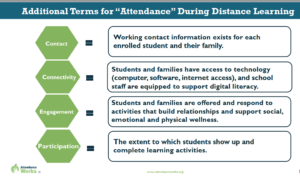“texting parents may be an effective way to reduce chronic absence in elementary school. “
Category: Research on Absenteeism
Oct 05
The Urgent Need to Avoid Punitive Responses to Poor Attendance, attendanceworks.org
“What improves attendance is partnering with students and families to identify and address the root causes that lead to students to miss school in the first place, whether absences are connected to barriers to showing up for school, negative experiences in school or a lack of engagement. Root causes can also be related to misconceptions about attendance, such as thinking that sporadic absences aren’t a problem, or missing two days a month doesn’t affect learning.”
Oct 02
Why so many students are missing so much school, attendanceworks.org
“There are many reasons students are absent and they fit into four broad categories: Barriers, Negative School Experiences, Lack of Engagement and Misconceptions.”
Aug 31
Measuring Daily Attendance and Participation During COVID-19 – An Invaluable Tool for Reducing Educational Inequity
“Until new research examining absenteeism in blended or distance learning settings can be conducted, we advise continuing to monitor which and how many students miss 10% or more of learning opportunities.”
Aug 15
Districts Pivot Their Strategies to Reduce Chronic Absenteeism During Distance Learning by Wade Tyler Millward
“Hedy Chang, executive director and founder of Attendance Works, says that when the new school year resumes, school officials may well find more students at risk for chronic absenteeism due to economic or housing instability. Parents may have lost their jobs, students may need to work to support the family, family members may have died due to COVID-19. And students may be unwilling to return to school in person if they have a health condition or live with someone who is more vulnerable to the virus.”
Apr 29
Practical suggestions for keeping secondary students connected during COVID-19
“STUDENTS WHO FEEL
CONNECTED TO SCHOOL…
• Have an adult in school, who they
believe knows about them and cares
about them as an individual
• Have a group of peers they interact
with and feel affinity with as a group
– i.e. sports teams, theater crews, clubs,
identity groups, circle of friends” Robert Balfanz, Johns Hopkins
Apr 22
Measuring online student engagement or taking attendance? Is it worth it?
“Virtual schools that have quantified attendance as “one interaction per week” fall well short of ensuring students are engaged,.”
Apr 21
Hundreds of thousands of students haven’t logged on, reports say
“How will we know who we need to apply some extra resources to reach and connect with? Our kids are everywhere.”
Mar 06
Kids knocking over class furniture, hitting others and physically harming self and others – all symptoms of trauma
One Ohio District’s experiences of dealing with student trauma in Early Childhood Education demonstrates how early identification, early intervention and multi-agency treatment programs can work. “Evidence suggests it works: children’s trauma symptoms, including anxiety, depression and post-traumatic stress disorder, are on average reduced by 30 to 50 percent over one school year.”











